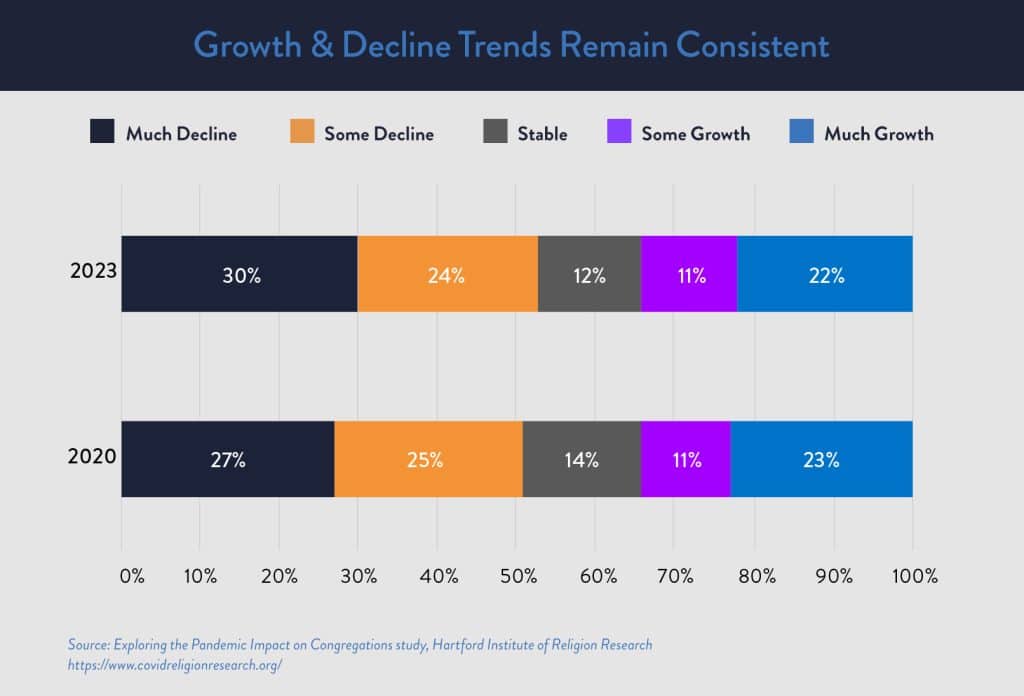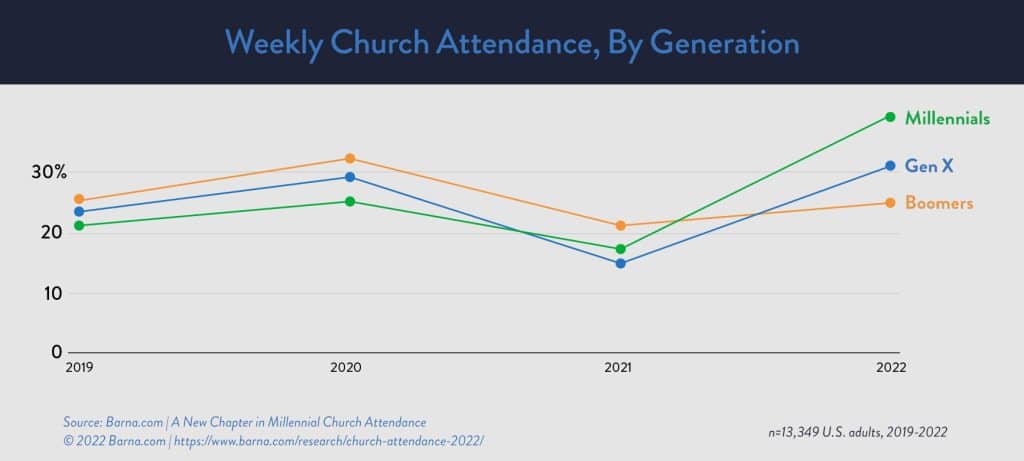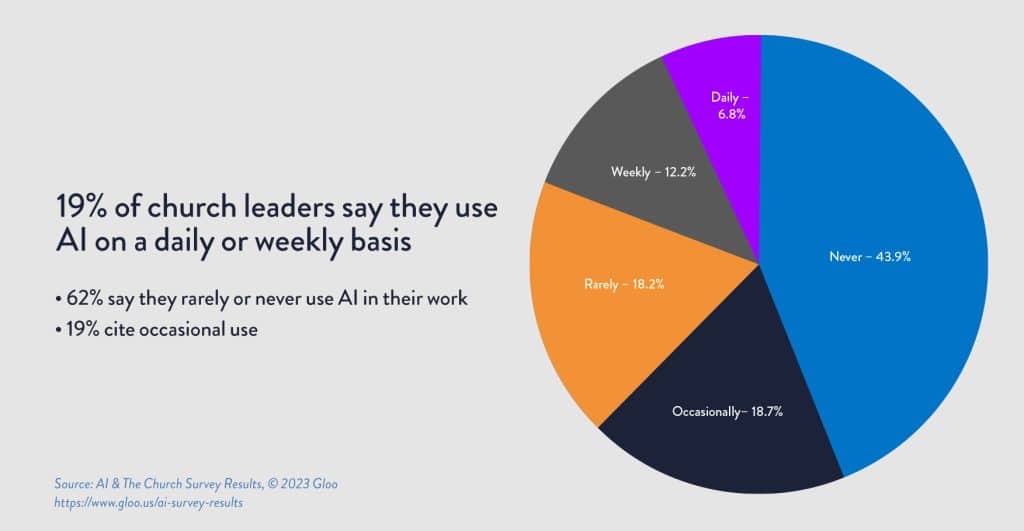2024 will be a pivotal year for most church leaders and probably will be for your church as well. 7 disruptive church trends are creeping up on us in 2024, and there’s no better time to prepare for them than now.
The dust has settled from the Great Resignation (it’s not even a thing anymore). If you made it through the last few years as a church leader, you’re probably in for quite a few more years to come.
So, after years of chaos and heartache for many church leaders, it’s time to look to the future. The horizon ahead isn’t all roses, but at least it’s addressable.
This year’s trends focus on the disappearance of the stable church, the new core of your church as Millennials and Gen Z move into their prime adult years, discipleship, technology (i.e. AI), and a new kind of emerging megachurch pastor.
Many trends I’ve outlined in the last eight years are still active. Here are the links if you and your team want to do a deep dive:
- 2023 Church Trends (The Decline of the Boomer Church)
- 2022 Church Trends (And the Post-Pandemic Era)
- 2021 Church Trends (The Rise of the Post-Pandemic Church)
- The Original 2020 is History: 7 NEW Disruptive Church Trends For 2020
- 2020 Church Trends
- 2019 Church Trends
- 2018 Church Trends
- 2017 Church Trends
- 2016 Church Trends
For the most part, many of the trends identified in the last eight years have emerged and are still relevant to what we’re all experiencing right now. Some accelerated dramatically.
So what’s next?
1. The “Stable” Church Has Become An Endangered Species

So, the return to in-person church has taken its toll on leaders and congregations over the last few years. The latest casualty? The stable congregation.
According to this recent survey, the stable church is now an endangered species. There’s an almost 90% chance your church is either growing or declining. Only 12% of respondents reported that their church was ‘stable,’ neither attracting new people nor shrinking.
Another way to think about this is that churches that have momentum are gaining even more momentum, while churches that don’t are losing people just as quickly.
What’s at Stake
It wasn’t uncommon for church leaders in the recent past to lead a stable church, meaning that their congregation hadn’t meaningfully grown or declined in years or, in some cases, decades.
That gave church leaders de facto permission to carry on ‘business as usual’—no significant changes to their weekend services, budgets, programs, or discipleship strategies.
Naturally, over time, that rarely produced a great result, but perhaps more dangerously, in established congregations, it gave people the false security that they had time to make any changes they wanted.
That’s now all but gone.Being part of a stable church gave people the false security that they had time to make any changes they wanted. That’s now all but gone.CLICK TO TWEET
Now, you’re either growing or declining, and most churches find themselves in the latter category, not the former. Fully 54% of churches are in moderate or significant decline. That means for over half of America’s churches, the writing’s on the wall.
The good news is that 33% of churches report ‘some’ or ‘significant’ growth. That’s deeply encouraging.
The nuance is that it’s unlikely that all this growth is just conversion growth (that would be great) but instead is transfer growth. Yes, people are dropping out of church and deconverting, but many others are simply moving from dying churches to vibrant churches.
The church consolidation trend I outlined in 2020 is in full swing. Attracting other Christians doesn’t fulfill your mission. Reaching people for Christ fulfills your mission. CLICK TO TWEET
What to Do
All of this means that change has never been more urgent.
In declining and dying churches, change, revitalization, and transformation must happen quickly, or else many congregations’ futures are in doubt.
In growing churches, it’s different. First, the changes leaders made a few years ago are likely fueling the growth. They’re reaping what they sowed. And that’s good news. It’s also critical to understand why the growth is happening so that you can continue to reach more people effectively. These growing churches will form the nucleus of the future church.
The caveat is that even if your church is experiencing significant growth, it’s essential not to neglect reaching unchurched people.
Attracting other Christians doesn’t fulfill your mission. Reaching people for Christ fulfills your mission.
The bottom line? These days, you’re either growing or declining as a church. Stable isn’t happening much anymore in a rapidly changing culture.These days, you’re either growing or declining as a church. Stable isn’t happening much anymore in a rapidly changing culture.CLICK TO TWEET
2. Millennials Are The New Core of Your Church

One of the most significant shifts of the last few years is that Millennials have embraced church attendance faster than any other demographic, surpassing their attendance levels back in 2019.
Millennial attendance is surging, especially among non-white Millennials.
According to the same Barna survey, 30% of white Millennials report attending church regularly post-COVID, up from 26% pre-pandemic. But non-white Millennials have returned with even greater zeal. Fully 40% of non-White Millennials say they are attending church post-COVID, up from 31% pre-pandemic. Millennials have embraced church attendance faster than any other demographic, surpassing their attendance levels back in 2019. CLICK TO TWEET
Of course, this is also partly fueled by the fact that Boomers didn’t come back to church the way most people expected them to.
One megachurch pastor told me that to him, it feels like Boomers retired from church. He said, “They discovered they enjoy that 2nd cup of coffee on the couch… and an earlier tee time on Sunday! I did not see that coming ;-)” The truth is, very few of us did.
According to Barna, 31% of Boomers attended church regularly before 2020, but only 22% kept attending post-pandemic.
Some of this is natural as Boomers get older and factors like mobility and health become more significant, but the writing has been on the wall with Boomers for years. We just behaved like it wasn’t. The writing has been on the wall with Boomers’ declining church attendance for years. We just behaved like it wasn’t. CLICK TO TWEET
What’s at Stake
The two areas most impacted by this trend (other than attendance) are serving and giving. Boomers have historically carried congregations both in terms of finances and volunteering.
With them stepping out of the picture, it’s critical for church leaders to engage the new Millennial reality. That will come with some nuances church leaders need to master quickly.
First, Millennials are less likely to commit to serving ‘forever’ than previous generations. They have busy lives, and their kids take up a lot of time and resources, as do their careers.
Second, Millennials give differently than Boomers or Gen X did. It’s true that more Millennials donate to churches than Boomers do (there’s more on that here).
Younger Millennials and Gen Z (see Trend #3 below), however, show more of an ‘all-in’ approach to discipleship than other generations. I’m not saying Boomers or Gen X weren’t serious about their discipleship, but their discipleship was often expressed as attending, giving, and serving.
If you think about it, in many ways, the outgoing model of the church made giving and serving the ‘goals’ of discipleship—that’s how you knew people were engaged.
With millennials, and soon Gen Z, giving and serving isn’t the goal of discipleship; they’re the by-product of an intense faith that has taken over their lives.
Semantics? Maybe. But it will feel less and less like semantics the further into the future we get.
What to Do
While you don’t want to give up on Boomers completely — and you’ll want to honor them for their contribution — it’s critical to understand that the oldest Millennial turns 43 in 2024. It’s high time to treat them (as well as Gen X and older Gen Z) as the new core of the church.
For reasons outlined above, churches that focus on helping people become whole-hearted followers of Jesus will have to worry less about how the next generation gives and serves than churches that make giving and serving the goal. Churches that focus on helping people become whole-hearted followers of Jesus will have to worry less about how the next generation gives and serves than churches that make giving and serving the goal. CLICK TO TWEET
Similarly, raising the bar on how we call Millennials to serve will result in a better response than lowering the bar or hoping lots of people step up. Here are some tips on how to do that.
When it comes to giving, again, a call to radical discipleship that involves all of life will help foster generosity in the next generation.
But two more conversations need to happen. The first circles around the generational wealth transfer that’s about to take place. As Boomers age and many start passing away, their Gen X and Millennial children will receive the most significant wealth transfer in human history. Stewardship should become a part of that conversation with Boomers. Otherwise, the church will likely be ignored both by the giver and the recipient.
Second, church leaders should create a strategy around engaging Millennials as critical donors for the future of the mission and vision. That means developing a strategy to help them see that Jesus is a priority, as they’re used to giving to various social causes that have captured their attention. This can help with that.
3. Gen Z Will Start to Reshape the Church
In the same way Millennials have grown up, the oldest Gen Z turns 27 in 2024. Many are hardly kids anymore, and they’re definitely not just ‘students.’ They’re adults, and in 2024, you’ll start to see how Gen Z is reshaping the church.
I outline five characteristics I see in Gen Z worship in this post. I won’t repeat everything I wrote there, but let’s say the next era of the church will likely be less produced, more personal, less performance-based, more authentic, and, finally, less head-driven, more heart-driven.
In addition, the Gen Z who have stuck around want to go all in on their faith. They’re not interested in Christianity ‘light’ or the ‘we attend church’ faith of their parents. They want to follow Jesus with passion and are ‘all in’ on community. Serving, giving, and evangelism are all by-products of their all-or-nothing faith. Gen Z church will likely be less produced, more personal, less performance-based, more authentic, and, finally, less head-driven, more heart-driven. CLICK TO TWEET
What’s at Stake
Five years ago, I named the stalling out of the attractional church model as a church trend, but in 2024, many churches are still doing some variation of the attractional church model. As a result, even more churches (that are still doing the same old thing) are plateauing or declining.
A new model hasn’t emerged yet, but I think 2023’s Asbury revival and some spontaneous baptism services we also saw point the way to the future.
Gen Z is a generation hungry for God, hungry for hope, and a generation done with hype. If you keep running church the ‘old way,’ you risk losing a generation passionate about Jesus.
The challenge, of course, is how the intensity and devotion characteristics of the small percentage of Gen Z still around in the church will translate to Gen Z who aren’t Christian.
The discipleship culture they’re fostering is fantastic, but it has to lead to evangelism to truly renew the faith. Chances are it will, unless, like so many ‘discipleship’ movements of the recent past, it turns into an ‘us vs. them’ dynamic. I don’t see that now, and I hope it doesn’t turn that way.
What to Do
The best strategy for involving new generations is simple: Stop trying to ‘reach’ them or ‘speak for them.’ Invite them around your leadership table instead, and let them shape and make decisions.
Gen Z doesn’t just want a seat at your table; they’d like a voice and a vote. They also deserve one.
The best way older leaders (like myself) stay current is by engaging the next generation and letting them shape the future.
With the average senior pastor of American churches turning 60 this year, it’s time to let the next generation lead. Gen Z doesn’t just want a seat at your table; they’d like a voice and a vote. They also deserve one. CLICK TO TWEET
4. Discipleship Has a Growing Digital Component
One clarion call across much of the church in the last few years has been the need for better discipleship.
What no one is talking about, though, is that very few churches are discussing how digital ministry fits into the discipleship framework. The subtext of the dialogue has been, “Let’s just get everybody in the building, and we’ll figure it out.”
Meanwhile, a few churches and organizations have been producing fantastic resources and results on discipleship, and they’re doing it digitally.
Churches like Churchome and Life.Church have reached thousands of young adults, connecting them through their website and app. They are also seeing (tens of) thousands gather in person in their local communities, fueled by what their digital presence provides. (David Kroll, Churchome’s CEO, shares more on their strategy here).
Another megachurch pastor I talked to said their church saw almost 30,000 prayers prayed by their campuses in a single week, fueled by their mobile prayer app. Digital discipleship is here to stay, and growing churches are investing heavily in it.
A final case for consideration is that of John Mark Comer. Few people are doing more to advance the cause of discipleship and a Rule of Life in this generation than John Mark. Yet his delivery system for his discipleship resources through Practicing the Way is entirely digital. The digital resources, though, fuel in-person interaction, community, and discipleship.
What’s At Stake
The hybrid church has been a trend for years in this space (not this year because, well, it’s just normal now), but still, many churches hold out, limiting their online presence to try to fuel in-person attendance. That hesitancy over digital is magnified even more when it comes to discipleship.
To put it bluntly, to treat your online platform as an evangelism resource or growth strategy and to ignore it as a discipleship vehicle is downright foolish.
It won’t be long until you legitimately say, “If you don’t have a digital delivery system for your discipleship strategy, you don’t have a discipleship strategy.”
Yes, that digital thrust will push to in-person community and interaction. But, still, digital delivery is the catalyst.
Digital scales in a way that analog doesn’t. It won’t be long until you legitimately say, “If you don’t have a digital delivery system for your discipleship strategy, you don’t have a discipleship strategy.”CLICK TO TWEET
What to Do
Start thinking about how your church can use your digital platform to foster discipleship, not just to broadcast your services or reach more people.
Then, invest the budget and personnel you need to make it happen. And don’t feel the pressure to reinvent the wheel. There are many done-for-your resources out there.
5. Partisan Extremism Will Continue to Fuel Short-Term Church Growth (But Not Long-Term Growth)
Over the last few years, more than a few conservative pastors have seen rapid growth by choosing a side in the culture wars and taking positions on partisan political issues. (To be fair, progressive pastors sometimes take hardline stances, too, but rarely see any growth as a result).
Given that 2024 is an election year, expect this trend to peak in November in the hopes that a pastor’s slate of candidates or ideology wins at the box office.
What’s at Stake
The moment you wade into partisan politics (or political conversations that take a very narrow point of view) is the moment you alienate at least 50% of the people you’re trying to reach.
It’s one of the things churches do that isn’t in the New Testament, and it isn’t helping long-term outreach. If you want to turn off younger voters, turn your pulpit into a partisan platform.
As this perceptive and thoughtful article in The Atlantic points out, taking strong stands can be a way to temporarily grow your church in this environment. But the author argues that, ultimately, partisan politics is poisoning the evangelical church. Sadly, I agree.
What to Do
While it’s easy to say that pastors are being ‘courageous’ for taking a stand on a partisan issue or in favor of a political party, it’s prudent to ask whether that’s really being courageous.
As Duke University’s Chris Bail’s research shows, just 6% of the radical positions on social media drive 73% of all traffic online (thank you algorithms). But he also points out that most people are not extremists. They’re moderates. Just 6% of the radical positions on social media drive 73% of all traffic online. Most people are moderates. CLICK TO TWEET
What if it’s not courageous to take a partisan position from the pulpit?
What if being courageous these days means becoming an alternative to the culture, not an echo of it?
If you flip the calendar ahead a decade, the future church will consist of Christians who look, live, and sound much more like Jesus than the political candidate of their choice.
Many church leaders are about to face this truth: Neither unchurched people nor the next generation are looking for politics or ideology at church. They’re looking for Jesus.
Church leaders who point them in that direction will lead the next generation of growing churches.What if it’s not courageous to take a partisan position from the pulpit? What if being courageous these days means providing an alternative to the culture, not an echo of it? CLICK TO TWEET
6. AI Adoption Will Become Normative in Growing Churches

If 2023 had a headline, it would have something to do with the rapid embrace of AI.
Let me nuance that.
As the above data from Gloo reveals, almost everyone has embraced AI widely and rapidly, except in the church, where it’s been greeted mostly by yawns, disinterest, and leaders’ pontification on how it should be condemned. Right now, only 19% of church leaders say they use AI on a daily or weekly basis.
That’s about to change quickly.
As 2024 opens, many startups and entrepreneurs are creating new software to help churches leverage AI, and legacy companies and brands are integrating AI into their existing software.
This year, almost every growing church will lean into AI to help reach more people, personalize their messaging, understand their metrics better, and create sermon resources like study guides, social posts, and much more. By the end of the year, we’ll be amazed at how many new technologies will be available to help churches accomplish their mission.Almost everyone has embraced AI widely and rapidly, except In the church, where it’s been greeted mostly by yawns, disinterest, and leaders’ pontification on how it should be condemned. CLICK TO TWEET
What’s at Stake
Resistance to AI will gradually wear down, in considerable measure, because it’s being baked into almost every legacy software and social media platform. It will simply become normative.
Some resisters will remain, but adoption will go more mainstream.
That said, there are deep existential questions that AI raises. We don’t fully understand what we’re building or what we’re using, and there will be a host of unintended consequences.
But the AI ship has sailed, and it’s not heading back to port.
If you want more, I explore the theological, philosophical, and moral questions AI creates in this podcast series, where I interview some top global leaders on the subject.The AI ship has sailed, and it’s not heading back to port.CLICK TO TWEET
What To Do
Wise leaders will ethically embrace and use AI to further their mission. They’ll also study the subject and consider as many implications as possible.
While larger churches have the leverage to hire staff and experts to help them with AI integration, leaders of smaller churches should look to two sources to help: business leaders who are up on AI and young leaders. Both are likely willing to volunteer their time to help you understand how to use AI to further your mission.
The final thing every leader has to consider is that regardless of your personal feelings about AI, artificial intelligence is changing the lives of every person you serve or hope to reach.
Some will lose their jobs. But AI impacts far more than work. Numerous people, already hooked on porn, are building virtual relationships with AI sexbots (no, this is not an idea…it’s happening).
Others are looking to transhumanism to extend their lives. People are losing even more touch with any authentic community and a faith that grounds them in what never changes. From a pastoral perspective, this mixture of life challenges will be impossible to avoid in 2024. Wise leaders will understand and address the issues AI presents to our culture.
Finally, in an era of deep fakes, lies, and scams, authenticity and deep personal connection have become rarer than ever. The good news is your ministry’s genuineness and authenticity will become some of the most unique aspects of what you offer the people you serve and the world.
In 2024, authenticity, far from overdone, will become a superpower. And the ability to distill meaning amid the AI madness will be more critical than ever. In 2024, authenticity, far from overdone, will become a superpower. And the ability to distill meaning amid the AI madness will be more critical than ever. CLICK TO TWEET
7. A New Kind of Megachurch Pastor Will Continue To Emerge
We’ve all sadly watched megachurch pastor after megachurch pastor resign as a result of a scandal. Many have also led well and stepped back (quietly) after decades in ministry. Of course, those stories never get coverage, but many of them do exist.
The story that rarely gets told is of the leaders who replace these legacy pastors. Sometimes, they’re young Gen X leaders, but more often than not, they’re Millennials.
Here’s what’s interesting. You probably can’t even name five of them.
Many of these leaders embrace a totally different style than their predecessors.
They’re:
- Less top-down and more consensus-based.
- Less interested in popularity and platform and more interested in local ministry.
- Less concerned about their name getting out there and more concerned about leading well in their context.
- Less focused on bringing back the past, and more focused on building a new future.
- Less fixated on size and more fixated on health. Ironically, with that focus, many are now leading a church larger than that of their predecessor.
I’ve personally met dozens (maybe 100+?) of these next-gen large and megachurch leaders, and I love them. Obviously, they’re subject to the same temptations and challenges that their predecessors and any other leaders are, but I sense they’ve learned from the past, and they represent the future of the church. The new generation of Millennial megachurch pastors are less interested in popularity and platform and more interested in local ministry. You probably can’t even name five of them. CLICK TO TWEET
What’s At Stake
A new generation of church leaders is growing up quietly before our eyes, and it’s genuinely wonderful to see.
This new style resonates better with younger Millennials and Gen Z. It might provide a new model for what a pastor looks like in the future church.A new generation of church leaders is growing up quietly before our eyes, and it’s genuinely wonderful to see. CLICK TO TWEET
What To Do
As I mentioned earlier, the average senior pastor in America turns 60 this year. As the succession crisis intensifies, it’s time to stop looking for ‘another you’ and perhaps study what’s made for successful transitions elsewhere.
If we embrace a different kind of leader moving forward, the chances of churches getting healthier and reaching new people rises.
Sean Morgan and I cover how to make these transitions healthily in this course that’s helped hundreds of next-gen leaders and their predecessors step into the senior pastor role.
It’s refreshing to see a new generation step up. Hopefully, 2024 will continue to see leadership renewal in many churches.







